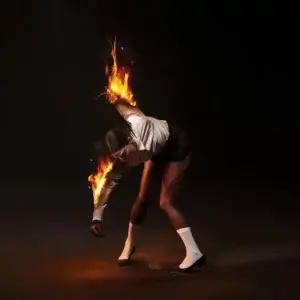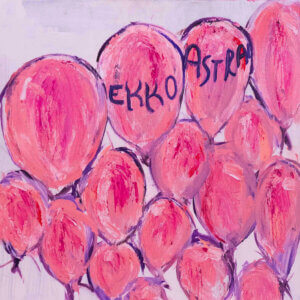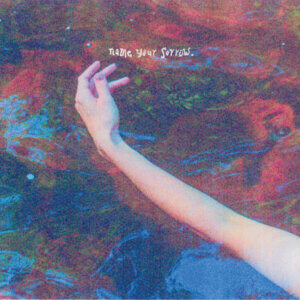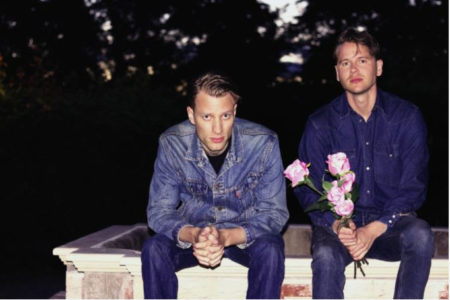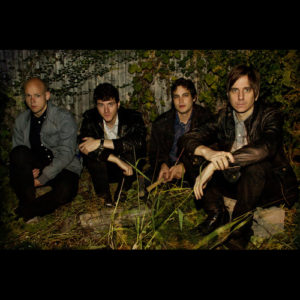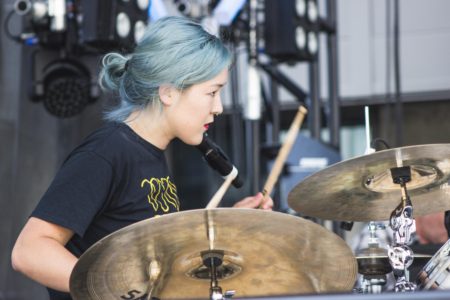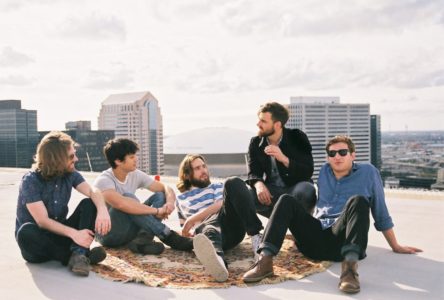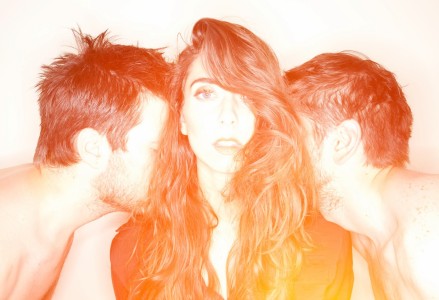Interview with Nate Eiesland from On An On
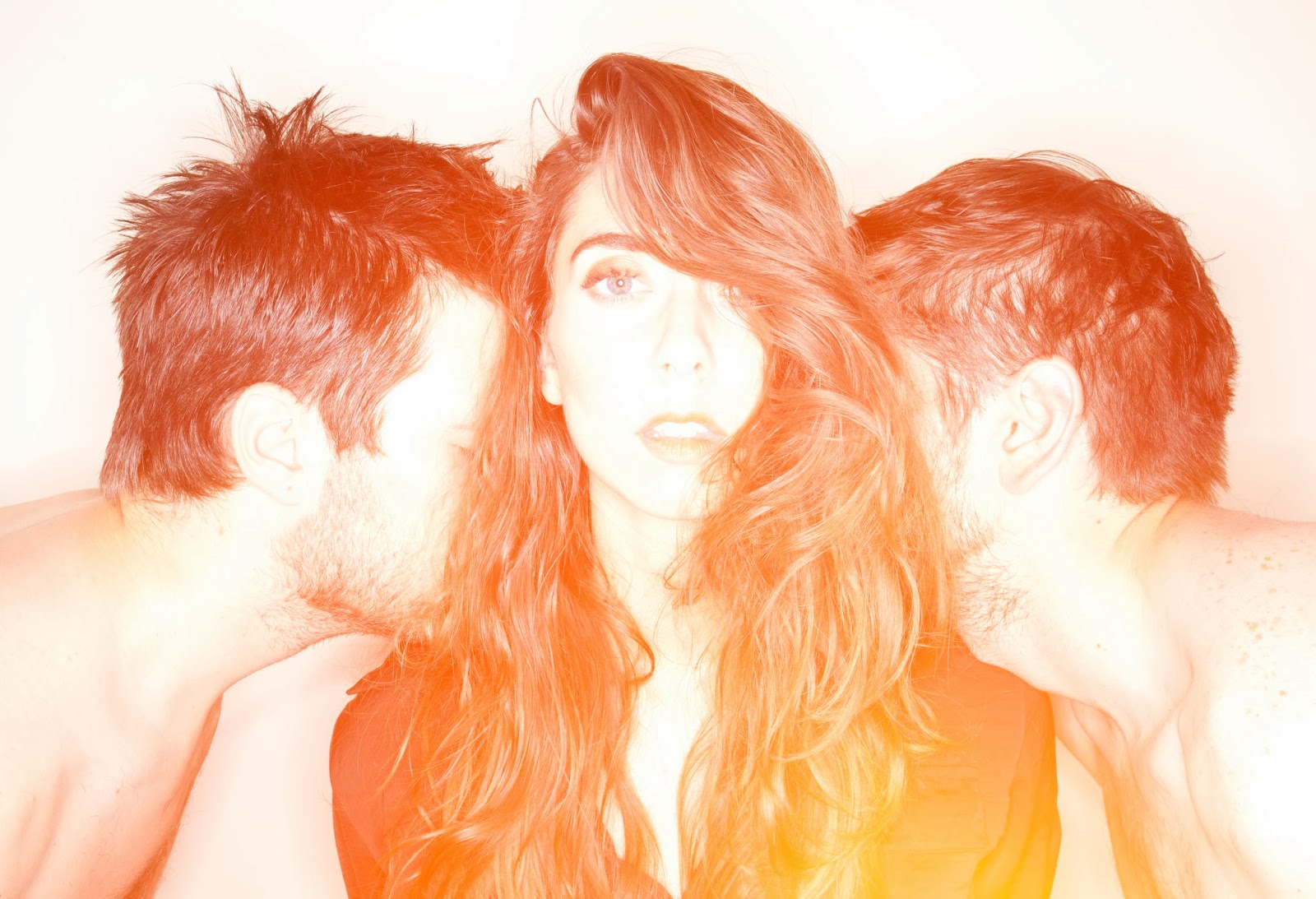
Following the 2013 release of their excellent debut record Give In, Minneapolis-based experimental pop band On An On earned itself new band to watch endorsements from the likes of Time, NPR, and MTV. That the trio of Nate Eiesland, Alissa Ricci, and Ryne Estwing began its recording sessions without a definitive plan as to what their sound would actually be makes the result even more impressive. “We just had some demos and a blank slate. It felt like selling all of your possessions and starting fresh”, says Ricci of their debut.
The band returned last summer with its follow-up, And The Wave Has Two Sides, which they recorded over two and a half months in LA with producer Joe Chiccarelli (White Stripes, Spoon, The Shins). Support for the record has seen them hit the road for a jaunt across the U.S. with Big Data, as well as headline their own trek across the continent.
Jeffrey Powell caught up with lead vocalist Nate Eiesland on the phone to discuss their latest record, the effects of surfing and what the future holds for the band’s live show.
Northern Transmissions: When we first spoke back in September 2013, you’d mentioned that you’d written half the songs for your follow up record. How much of that material actually ended up on And The Wave Has Two Sides?
Nate Eiesland: Probably a few songs from that bunch. I think we ended up with about thirty songs to choose from for the record.
NT: How did things change over that time?
NE: They just kind of developed as we wrote more. We tried some different writing styles to see what would come out. It’s really that last 10% of the writing process that I think really brings it into being something (hopefully) much better than before.
NT: With Give In, you’d spoken about being a new band at the time and trying new things over the writing process to develop your sound. I’d read that this time around you all wrote a bit more collaboratively. Can you expand on that?
NE: Some of the songs we wrote together. Or, I’d have the seed of an idea that I knew was worth developing. Alissa and I would try to write the song and make it blossom. The real collaboration in the band happens when working on the arrangements. We tried out ideas altogether in pre-production, which was cool. I don’t know if we’ll do it again that way next time, but it was really healthy for us to try out some of those things to help us stretch our boundaries a little bit.
NT: Ryne made the move from Chicago to Minneapolis between records, is that right?
NE: Yeah, he moved to Minneapolis when we stopped touring Give In.
NT: Was the move made for the band?
NE: Yeah, Alissa and I were pretty much nomads for the first couple of years of On An On. Ryne had a place in Chicago. All of our stuff was in Minneapolis, and that’s where we’d go when we got off tour. When we started writing for the next record, it was apparent that we all really wanted to be in the same city. It ended up being a natural progression for us to all live in Minneapolis.
NT: I know you’d been lumped in with Chicago bands in the past.
NE: I think we have a phantom hometown vibe in Chicago. When we play shows there, it can feel like that because we’ve all lived in there. Our college band [Scattered Trees] was from Chicago. Alissa and I grew up here in Minnesota, and I’ve always come back and spent lots of time here. I think we’re far enough past the very beginning of the band that people don’t really pay too much attention to the little bit of dual citizenship that we had there for a while in the beginning.
NT: You recorded And The Wave Has Two Sides over three months at Sunset Studios with Joe Chiccarelli. Were you guys in LA for the entirety of that time?
NE: We were in California for the whole time. It was two and a half months with a two-week break in the middle. It was an interesting way to make an album, though it was way more time than I’d like to spend doing it going forward. It’s too much time to doubt what you’re doing.
NT: In that respect, how long did it take to complete the majority of the material? Did you find yourself spending most of that time going over the songs in detail?
NE: We spent a couple weeks doing pre-production with Joe to get the songs as lean as possible. We knew that when we actually went into the studio that we didn’t want to waste time working on arrangements. We just wanted set everything up and start playing and recording.
Tracking probably took us two and a half weeks. We followed it up with two weeks off, which we spent driving up the Pacific Coast Highway (which was ridiculously gorgeous).
When we came back, we did vocals, and any overdubs or things that we needed to fix. And, then it was a couple weeks of mixing.
NT: Over that two-week break, did you completely layoff listening to what you’d recorded to that point?
NE: We took a definite break from the music. It was necessary for us to get some fresh ears back in the studio because you get so deep in recording mode that to be able to spend some time away is a healthy thing. Sometimes you’ll come back and find that the recorded parts that you loved end up being a little bit less exciting. And, sometimes other things that bothered you become the thing that you love. It’s giving it that space to have those changes occur. It’s important to let it mature on its own a bit.
NT: The bio for your new record references a sunny California influence on the music. From your perspective, did the songs change much between writing and recording?
NE: Not really. I think the sunny influences are more of subtle thing. We were working eleven-hour days, six days a week. Sundays were our day off, which we’d use to go and hang out at a different beach. We learned to surf and would go every time we were out there. There’s something about getting in the ocean and riding waves that had this really profound influence on the whole process. Something about being one with the wave and you’re riding on it, not fighting it. It’s not really working against you. You kinda disappear because you can’t think about something else. You’re only in your body, balancing. That experience was a really important thing for us.
NT: I caught one of your sets at SXSW last year and recall you introducing It’s Not Over by pointing out that you’d do the song sans guitar and with some dancing. How’re your moves these days?
NE: (laughs) I think touring that song I got more comfortable with that. It’s the only song that I did that so I didn’t really get to push that far. We don’t really play that song much anymore, though. I know it was a single, but it works way better as an encore, if we’re headlining and that happens.
NT: You guys recently added a new guitarist to your live show. What was the approach to making that change?
NE: We tried it to cover the guitar overdubs from the record and we wanted to have a big crew with us while touring this album. He’s also a friend of the band and a good guitarist. But, we’re just a four piece for this tour because we just needed to see what would happen if it was just the minimal stuff again. We’re actually looking at trying some stuff as a three piece.
NT: Oh wow.
NE: It’s exciting to be that vulnerable. I feel like there’s something there for us to explore. I think we’ll end up continuing as a four piece for the rest of the tours for this album, but I want to explore the electronic side of On An On. The whole mantra of the band is that we just kind of do whatever we want. (laughs)
NT: How have the songs evolved live over the tours that you’ve done so far?
NE: Mostly in the arrangements. There are some things on the record that were maybe really important, but have a negligible effect live. You have to pick and choose where we can give the most for the experience of the song. That means we’d end up a little bit different. We always try to achieve the same kind of emotions and go to the same length that we did on the album.
Latest Reviews
Tracks
Advertisement
Looking for something new to listen to?
Sign up to our all-new newsletter for top-notch reviews, news, videos and playlists.
